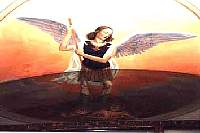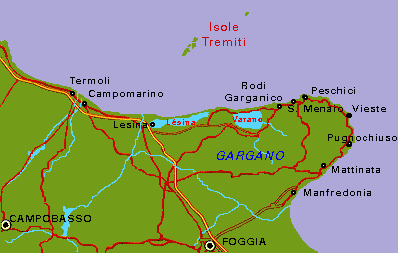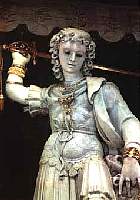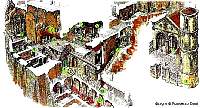Pilgrimage with Saint Michael the Archangel
Part 2
San Giovanni Rotondo
 |
| Saint Michael above the choir of the friars in the church of the Cappuccins in San Giovanni Rotondo (FG) Italy. |
Monte Sant'Angelo
There are at least three famous places in Europe consecrated to St. Michael and these sanctuaries are associated with probable revelations of the archangel. The earliest of these sanctuaries seems to be the one on Mount Gargano in Italy where the first revelations of the archangel are certified as early as the end of the fifth century. This mountain is situated in the south of Italy, where the boot-heel of the peninsula juts out into the Adriatic Sea, a region which during antiquity was part of the Neapolitan realm. St. Michael revealed himself to St. laurentius, bishop of Siponto, today the diocese of Manfredonia.

The Gargano peninsula
According to tradition the cave where the revelations occurred was a place where the first Christians hid to get away from the persecutions. Under Pope Gelasius I Gargano, a rich cattle-breeder, happened to lose a valuable bull. When Gargano and his men were out looking for the bull they arrived at this cave. They were not keen on entering the cave, but one of them shot an arrow into it to rouse the bull. To everybody's surprise it returned to the archer. The bishop of Siponto who belonged to the company admitted that this occurrence was very remarkable. He prayed and fasted for 3 days to understand the importance of this mystic event. later the archangel revealed himself to the Bishop. St. Michael declared that he himself had been in the cave and had sent the arrow back. He also said that he protected this place and that the Bishop ought to build a church in honour of St. Michael and all other angels. You will notice his his magnanimity when including all the other angels so that they might be honoured which confirms a simple truth:his supremacy. As far as I know St. Michael never urged anybody to build a church in his honour or in honour of the 3 archangels, however great they are.The archangels are generally praised among the 7 spirits serving before God愀 throne.
| Saint Michael's basilica in Monte Sant'Angelo. The history of the Basilica goes back to the 5th century. |
later on the Bishop entered the cave and discovered that it had the same form as a very beautiful chapel and he said mass there. Then a church was built there, called Monte Sant' Angelo, in memory of the revelation of St. Michael. Many miracles made it famous. Much later it became a resting-place for the crusaders on their way to the Holy land. The many marks off favour through St. Michael made the place the goal of many pilgrims from all over Europe. Today many pilgrims still visit Monte Sant' Angelo. Padre Pio da Pietralcina encouraged the pilgrims to visit the sanctuary. He himself had a great devotion for St. Michael. The 8th May was consecrated to the revelation of the archangel
 |
| The statue of Saint Michael from 1507 by A.Contucci.The grotto in the basilica, Monte Sant'Angelo. |
It is confirmed that in the sanctuary on Mount Gargano there have taken place four different revelations. The last revelation registered is the one in 1656. At that time many people were rescued from the plague. St. Michael´s interference is also certified in the great victories at Siponto over the Goths in 490 and over the Neapolitans in 663. In connection with the latter victory Michael appeared again. The Neapolitans had decided to wage war against Siponto and Benevento. In this situation the Bishop asked the inhabitants to fast and pray for 3 days to achieve Michael's help. Michael then appeared before the Bishop and told him that God had heard their prayer. He further urged them to attack the enemy at 4 o'clock on the appointed day. At this time Mount Gargano was darkened by clouds and shaken violently. Suddenly arrows on fire came out of the mountain attacking and dispersing the enemy.The festival in memory of this victory on May 8 , 663, was called Apparitio S. Michaelis in the old Roman breviary, was celebrated on this date and spread in the latin church.
